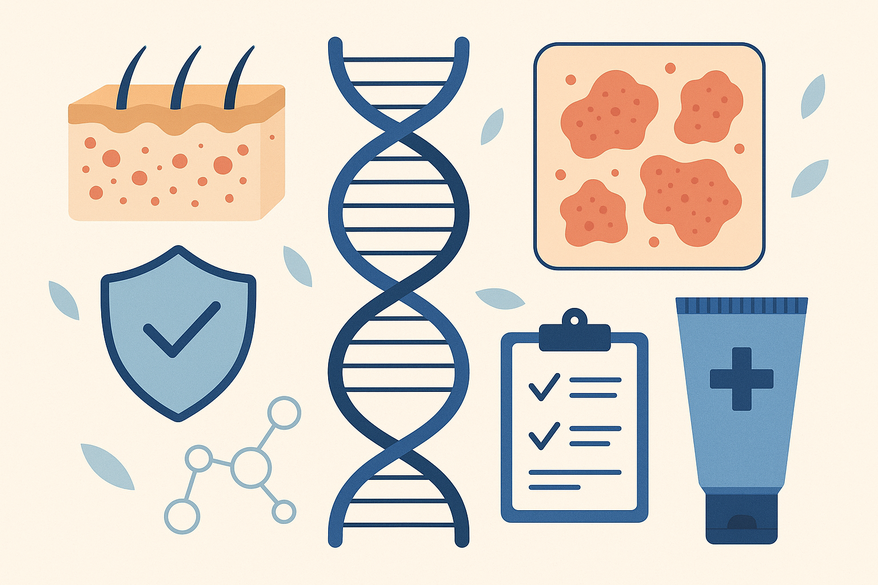Understanding Hereditary Rashes Risk Factors: How Genetics Influence Skin Rashes
Explore hereditary rashes risk factors and how genetics influence skin conditions like eczema. Learn about prevention and tailored management strategies.

Estimated reading time: 10 minutes
Key Takeaways
- Genetic roots: Mutations like FLG and CARD11 weaken the skin barrier and heighten immune response.
- Family history matters: First-degree relatives with eczema or asthma double to triple your risk.
- Gene–environment interplay: Triggers such as harsh soaps or allergens determine rash onset and severity.
- Early intervention: Proactive detection and tailored management reduce flares and improve outcomes.
Table of Contents
- Section 1: Defining Hereditary Rashes
- Section 2: Genetic Factors in Skin Conditions
- Section 3: Detailed Analysis of Risk Factors
- Section 4: Other Contributing (Non-Genetic) Factors
- Section 5: Research Insights and Emerging Studies
- Section 6: Preventative Measures and Management Strategies
- Conclusion
Section 1: Defining Hereditary Rashes
Hereditary rashes are chronic skin conditions rooted in genetic inheritance. Variations or mutations in genes that regulate skin barrier integrity and immune response set the stage for persistent, itchy eruptions such as atopic dermatitis.
Distinguishing Hereditary vs. Non-Hereditary Rashes
- Hereditary: Family-linked gene variants impair barrier proteins or immune regulation.
- Non-hereditary (allergic): Contact dermatitis from soaps, metals, or plants.
- Environmental: Climate extremes, pollution, or pathogens without requiring gene predisposition.
Why this matters: Identifying a hereditary rash guides decisions on genetic counseling, long-term barrier support, and targeted therapies instead of one-off topical fixes.
For a data-driven perspective on your skin health, consider using Rash Detector, an AI Skin Analysis App that provides instant sample reports.

Section 2: Genetic Factors in Skin Conditions
Hereditary rashes risk factors include specific gene mutations passed from parents. Family studies show that having a first-degree relative with eczema, asthma, or hay fever doubles or triples your odds of developing atopic dermatitis. Genes follow inheritance patterns—autosomal dominant or recessive—and sometimes require both parents to contribute a variant for expression.
Key Genetic Markers
- FLG (filaggrin) gene mutations: Filaggrin builds the skin’s outer barrier. Loss-of-function variants weaken this barrier, leading to dry, itchy skin.
- CARD11 gene mutations: CARD11 regulates immune signaling pathways. In an autosomal dominant pattern, a single altered copy can trigger atopic dermatitis.
- Other barrier and immune genes: Variants such as SPINK5, TSLP, and cytokine-related genes combine to set overall risk.
Section 3: Detailed Analysis of Risk Factors
- Family history of atopic conditions: First-degree relatives with eczema, asthma, or hay fever increase risk by 2–3×.
- FLG or CARD11 mutations: Barrier dysfunction fosters dry, cracking skin; immune overreaction prompts flares.
- Early-onset or severe eczema in relatives: Infancy manifestations often predict a more aggressive course.
- Rare syndromes: Conditions like Ichthyosis vulgaris or Netherton syndrome involve widespread scaling and systemic issues.
Section 4: Other Contributing (Non-Genetic) Factors
Even with strong hereditary risk, environmental and lifestyle influences shape disease onset and severity. Genetics set the baseline; the exposome triggers or amplifies the rash.
Environmental Triggers
- Harsh soaps, detergents, or fragrances
- Air pollution, pollen, dust mites
- Extremes of humidity and temperature
Diet and Prenatal Exposures
- Maternal stress or antibiotic use during pregnancy
- Infant diet timing for allergen introduction
Lifestyle Factors
- Psychological stress, poor sleep
- Skin care routines that strip natural oils
Pathogens and Irritants
- Staphylococcus aureus colonization
- Viral infections like herpes simplex
Section 5: Research Insights and Emerging Studies
Ongoing research is paving the way to precision dermatology.
New Genetic Contributors
- Variants in desmoglein and loricrin genes affecting barrier cohesion
- Immune dysregulation genes (e.g., IL-13, IL-4) linked to inflammation
Birth Cohort Studies
- Indoor allergens plus FLG mutations predict eczema by age two
- Epigenetics: prenatal environment can switch genes on/off
Future Directions
- Personalized genomic profiling to forecast severity
- Epigenetic therapies to reverse harmful DNA methylation
Section 6: Preventative Measures and Management Strategies
Understanding hereditary risk allows for proactive measures to reduce flares and improve skin health.
Early Detection
- Monitor high-risk infants for persistent dry patches or intense itching
- Watch for red flags: onset before 6 months, widespread rash, sleep disturbances
- Seek genetic counseling for severe or syndromic cases
Ongoing Management
- Dermatology check-ups with updated family history
- Gentle skin care: pH-balanced cleansers, daily emollients, night-time barrier creams
- Environmental avoidance: humidifiers, soft fabrics, hypoallergenic detergents
- Dietary support: probiotics, omega-3 supplements, dietitian guidance
Flare-up Control
- Early use of topical corticosteroids or calcineurin inhibitors
- Infection prevention: clean and cover scratched areas
- Wet-wrap therapy for severe flares
Conclusion
Genetics set the stage for hereditary rashes risk factors, while environment and lifestyle write the script for onset and severity. By recognizing family history, known gene mutations, and non-genetic triggers, you can detect rashes early, adopt prevention strategies, and pursue personalized treatments. Understanding these risk factors empowers families to minimize flares, improve skin health, and enhance quality of life. Consult healthcare professionals for tailored assessment and management.
Call-to-Action
Enjoyed this guide on hereditary rashes? Share it with family members, subscribe for updates, and speak with a physician or genetic counselor if you’re concerned about your family history.
FAQ
- What triggers hereditary rashes?
Gene variants set the foundation, while environmental factors—like soaps, pollen, or climate extremes—trigger flares. - Can lifestyle changes prevent flare-ups?
Yes. Gentle skin care, stress management, and dietary adjustments can reduce severity and frequency. - How is genetic testing used?
Testing identifies key mutations (e.g., FLG, CARD11) to inform personalized treatment plans and counseling. - Should I see a genetic counselor?
If you have severe, early-onset, or syndromic presentations, genetic counseling can clarify risks and guide family planning.





